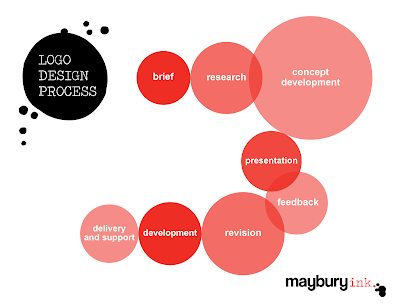And what you should get is a customised logo that effectively represents and differentiates your unique business, and appeals to your customers – not leftover concepts from someone else’s brief, or a rip-off of another logo.
A design professional will take the time to understand what your business does, your vision, values and personality, and who your customers are. They will spend time discussing your design ideas and preferences (and they may not agree with them and they will tell you why!). They will research your business category, competitors and symbols. They will explore and test ideas and concepts, and present you with multiple logo concepts to work from.
I thought it would be helpful to take you through the logo design process so you can understand the value of engaging a professional graphic designer:
- Brief: The designer will take a detailed brief about your business – vision, values, personality, products and services, and customers. They will want to know about any design ideas and preferences you may have, dislikes and so forth. They will draw out all the information they can to determine what attributes they will turn into a visual representation of your business. They will take lots of notes!
- Research: The next step involves researching the marketplace, competitors, businesses with similar personalities in other categories, as well as relevant symbols and icons. This research will help ensure your brand is differentiated and unique.
- Concept development: Alongside the research, ideas will be noted and sketched. There will be brainstorming, experimenting and then filtering and refinement of concepts until the strongest designs emerge.
- Presentation: Once the initial concepts are developed the designer should present at least two, but ideally three distinctly different logo concepts (not just different colours or slightly varied logos – that’s later in the process).
- Feedback: The designer will be interested in your initial feedback, along with your thoughts as you contemplate the designs over a few days.
- Revision: Your feedback will be incorporated into revised designs and updated concepts will be presented. Then there’s more feedback and further revision of the concepts – this may loop through two or three times.
- Development: Once you’ve decided on a concept, the final
logos will be developed – perhaps in vertical and horizontal versions, to work
as a single colour and in reverse; as well as versions for social media icons.
Logos should be created in various colour formats (PMS, CMYK, RGB) and in
various file formats (eps, png, jpeg).
Many clients also engage their designer to develop the visual identity that will accompany the logo, including colour palette, typography, graphic style and imagery. This would be refined at this stage and designs developed for stationery and marketing collateral.
- Delivery and support: You will receive your logos, and ideally a design style guide that outlines correct logo use and specifies colours, typefaces and more. A good designer will be able to help you roll out your new logo design, and be able to provide future services to build your visual brand identity.
As you can see, it’s quite a process! Although there are
cheaper logo design options out there, they really don’t compare to the value
you get from investing in an experienced graphic design professional. Remember,
all logos are not created equal.
If you're looking to develop a new logo, or evolve an
existing one and want to chat, please get in touch with me.


No comments:
Post a Comment